Chapter: Fundamentals of Database Systems : Advanced Database Models, Systems, and Applications : Overview of Data Warehousing and OLAP
Data Modeling for Data Warehouses
Data Modeling for Data Warehouses
Multidimensional models take advantage of inherent relationships in data
to populate data in multidimensional matrices called data cubes. (These may be called hypercubes if they have more than three dimensions.) For data that
lends itself to dimensional
formatting, query performance in multidimensional matrices can be much better
than in the relational data model. Three examples of dimensions in a corporate
data warehouse are the corporation’s fiscal periods, products, and regions.
A standard spreadsheet is a two-dimensional matrix. One example would be
a spreadsheet of regional sales by product for a particular time period.
Products could be shown as rows, with sales revenues for each region comprising
the columns. (Figure 29.2 shows this two-dimensional organization.) Adding a
time dimension,
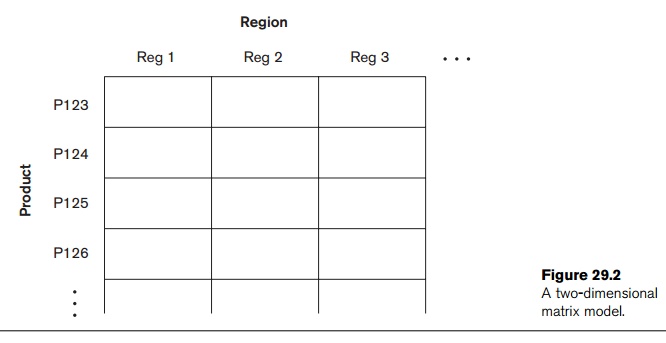
such as an organization’s fiscal quarters, would produce a three-dimensional
matrix, which could be represented using a data cube.
Figure 29.3 shows a three-dimensional data cube that organizes product
sales data by fiscal quarters and sales regions. Each cell could contain data
for a specific product,

specific fiscal quarter, and specific region. By including additional
dimensions, a data hypercube could be produced, although more than three
dimensions cannot be easily visualized or graphically presented. The data can
be queried directly in any combination of dimensions, bypassing complex
database queries. Tools exist for viewing data according to the user’s choice
of dimensions.
Changing from one-dimensional hierarchy (orientation) to another is
easily accomplished in a data cube with a technique called pivoting (also called rotation). In this technique the data
cube can be thought of as rotating to show a different orientation of the
axes. For example, you might pivot the data cube to show regional sales
revenues as rows, the fiscal quarter revenue totals as columns, and the
company’s products in the third dimension (Figure 29.4). Hence, this technique
is equivalent to having a regional sales table for each product separately,
where each table shows quarterly sales for that product region by region.
Multidimensional models lend themselves readily to hierarchical views in
what is known as roll-up display and drill-down display. A roll-up display moves up the hierarchy, grouping into larger units
along a dimension (for example, summing weekly data by quarter or by year).
Figure 29.5 shows a roll-up display that moves from individual products to a
coarser-grain of product categories. Shown in Figure 29.6, a drill-down display provides the
opposite capability, furnishing a finer-grained view, perhaps disaggregating
country sales by region and then regional sales by subregion and also breaking
up products by styles.
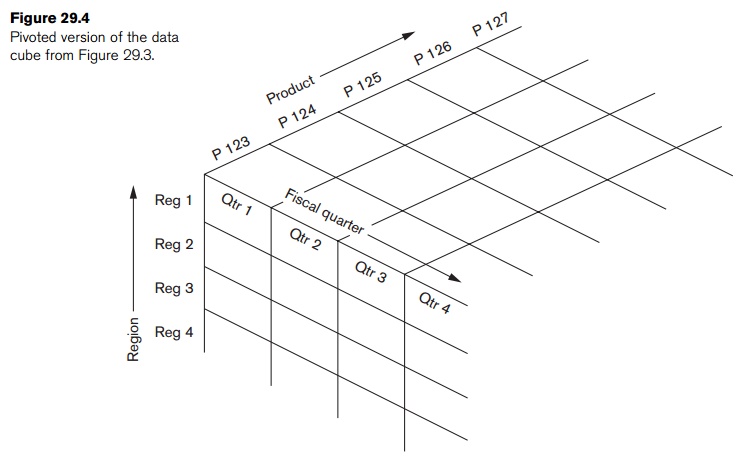
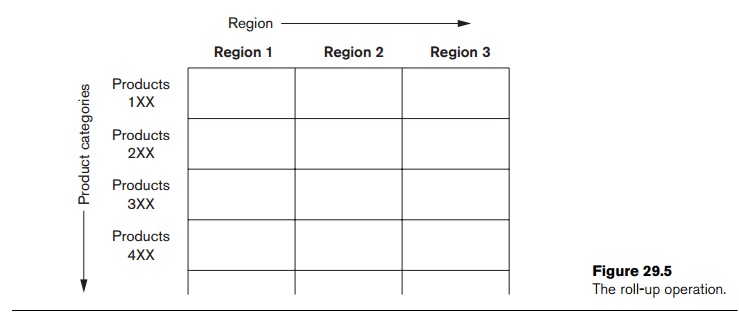

The multidimensional storage model involves two types of tables:
dimension tables and fact tables. A dimension
table consists of tuples of attributes of the dimension. A fact table can be thought of as having
tuples, one per a recorded fact. This fact contains some measured or observed
variable(s) and identifies it (them) with pointers to dimension tables. The
fact table contains the data, and the dimensions identify each tuple in that
data. Figure 29.7 contains an example of a fact table that can be viewed from
the perspective of multiple dimension tables.
Two common multidimensional schemas are the star schema and the snowflake
schema. The star schema consists of
a fact table with a single table for each dimension (Figure 29.7). The snowflake schema is a variation on the
star schema in which
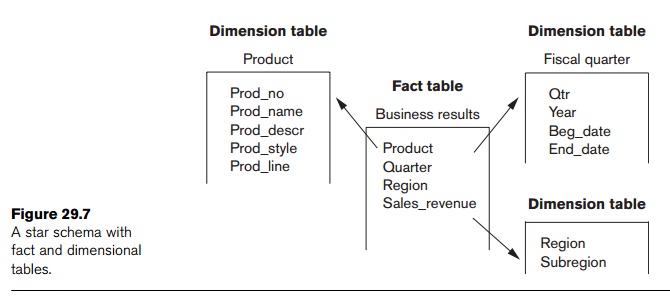
the dimensional tables from a star schema are organized into a hierarchy
by normalizing them (Figure 29.8). Some installations are normalizing data
warehouses up to the third normal form so that they can access the data
warehouse to the finest level of detail. A fact
constellation is a set of fact tables that share some dimension tables.
Figure 29.9 shows a fact constellation with two fact tables, business results
and business forecast. These share the dimension table called product. Fact
constellations limit the possible queries for the warehouse.
Data warehouse storage also utilizes indexing techniques to support
high-performance access (see Chapter 18 for a discussion of indexing). A
technique called bitmap indexing
constructs a bit vector for each value in a domain (column)

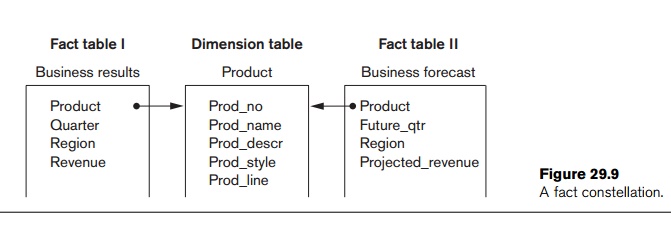
being indexed. It works very well for domains of low cardinality. There
is a 1 bit placed in the jth position
in the vector if the jth row contains
the value being indexed. For example, imagine an inventory of 100,000 cars with
a bitmap index on car size. If there are four car sizes—economy, compact,
mid-size, and full-size— there will be four bit vectors, each containing
100,000 bits (12.5K) for a total index size of 50K. Bitmap indexing can provide
considerable input/output and storage space advantages in low-cardinality domains.
With bit vectors a bitmap index can provide dramatic improvements in
comparison, aggregation, and join performance.
In a star schema, dimensional data can be indexed to tuples in the fact
table by join indexing. Join indexes are traditional indexes to maintain
relationships between primary key
and foreign key values. They relate the values of a dimension of a star schema
to rows in the fact table. For example, consider a sales fact table that has
city and fiscal quarter as dimensions. If there is a join index on city, for
each city the join index maintains the tuple IDs of tuples containing that
city. Join indexes may involve multiple dimensions.
Data warehouse storage can facilitate access to summary data by taking
further advantage of the nonvolatility of data warehouses and a degree of
predictability of the analyses that will be performed using them. Two
approaches have been used: (1) smaller tables including summary data such as
quarterly sales or revenue by product line, and (2) encoding of level (for
example, weekly, quarterly, annual) into existing tables. By comparison, the
overhead of creating and maintaining such aggregations would likely be
excessive in a volatile, transaction-oriented database.
Related Topics